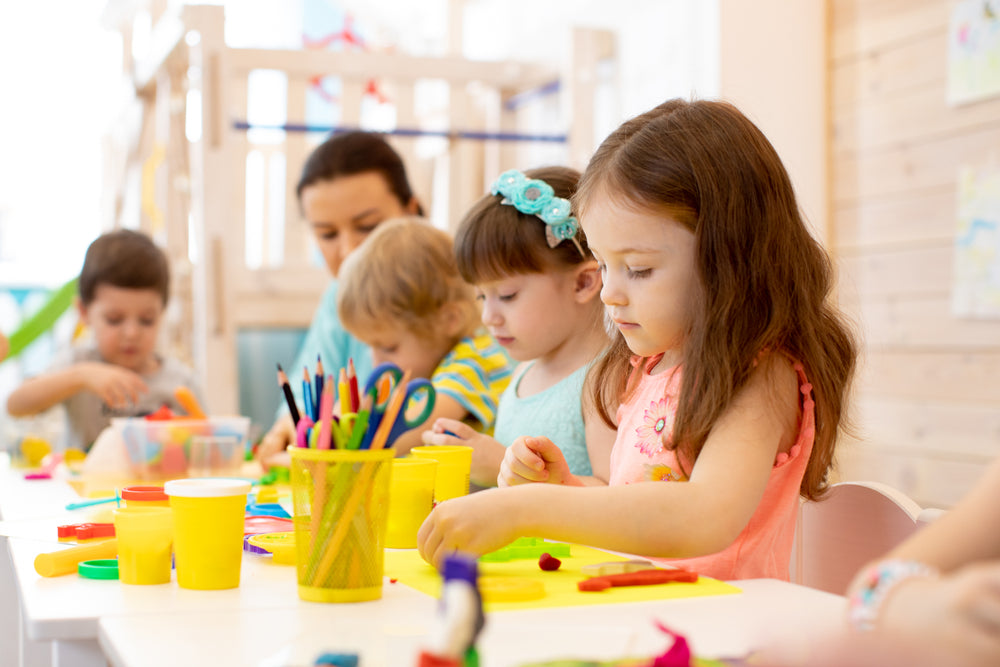How It Helps Children Learning In Childhood
Children's development and learning is broadly divided into three stages known as early childhood, middle childhood and adolescence. Every stage has its particular aims and objectives of creating a fulfilling experience and learning for a child. It is a proven fact that children are most curious in the early years, and their learning capacity is at the highest level. If the children are provided with the proper guidelines and variety of art and craft materials at home and in the schools, their learning can escalate tremendously.
This article will explain the importance of art and craft material usage in early childhood and primary school systems and how it enhances the children's learning experience and development.

How Children Learn In Early Childhood
The learning of a child begins with their arrival in the world. From a toddler to an early child, education is built on the basic principle of action and reaction. The primary learning process lies in the experience of a child, and this experience is directly linked with the five senses, which are as follows:
- Sight
- Hearing
- Touch
- Smell
- Taste

Suggested Read: Poster Painting Tips for Beginners
Through these five senses, a child interacts with the surrounding by using art and craft supplies to develop an experience. In the following article, we will give simple examples for each sense and how a child develops a learning experience by using one or more combinations of senses through art and craft material.
Art And Craft Supplies To Enhance Learning In Schools
Art And Craft Learning By Seeing
The sense of seeing is associated with learning by observation. For example, watching colours, textures, identification and differentiation of lightness and darkness of colours are the various domains of learning through seeing and observing. Art and craft activities about the primary colours, choosing the odd one out, number and alphabet recognition using educational charts and card games all fall into the category of learning by seeing.

Art And Craft Learning By Hearing
The sense of hearing helps children understand and learn the voices and tone of a sound of the environment and learning the language. The sense of hearing is crucial to speaking a language because if a child can't hear, it is challenging for them to speak fluently as the memory in the brain does not have a voice reference to imitate a sound. Sound variation also helps children differentiate between noise and music, hence developing the capability to identify between good and bad sounds in emotional tones. The art and craft activities like making a wind chime, shaker eggs, or guessing the sound help children recognize the variety of sounds in the school.

Art And Craft Learning By Touch
In early childhood, the art and craft activities in the school classroom focus on the physical interaction and engagement of children's body movement and tactile exercises. The objective of such art and craft activities is to enable a child to explore their body movement and control their gross and fine motor skills. The children doing yoga on the mats, making forms with playdough, sticking tape on a straight line, and painting within a basic shape are all beneficial activities to refine children motor skills using art and craft supplies.

Art And Craft Learning By Smell
The sense of smell is the most activated smell when a child is born. The study says that a newborn recognizes the mother through the sense of smell. For school children in the early years, the art supplies and craft material offer a variety of odour recognition directly or indirectly. For example, children making flowers with paper, colour drawings of candies and fruits or junk identify the smell as good or bad, sweet or sour etc.

Art And Craft Learning about Taste
The sense of taste is another very developed faculty in children. The art and craft activities focus on identifying the nouns/names of edible and non-edible things. Children's sense of taste supports their memory to retrieve the information about the taste of the fruit or vegetable and endorse learning development. Sweet, salty, sour and bitter-tasting things are usually the topics of learning and differentiation of flavours.

Final Words
The article covers the learning stages of a child using five primary senses, which facilitate a child's experience and learn from it. Also, it provides you with examples of how the engagement of the five senses through the art and craft activities and school supplies enhance and complement the learning experience in a child's development. The children are curious, and a variety of art and craft activities is an excellent tool for schools and teachers to utilize and engage a child in a playful way.
Image Source: ShutterStock
Also Read:

